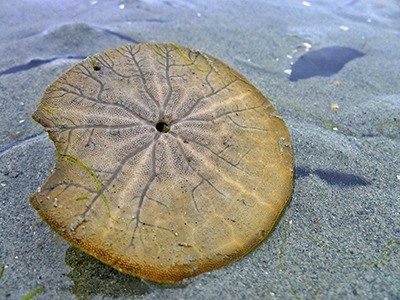From red octopus to giant clam worms to bay ghost shrimp the waters around our islands are home to fascinating creatures.
For Amy K. Henry, a doctoral candidate from the University of Chicago, these salty waters have enticed her to study two well-known – yet mysterious – species.
Over the summer, she has been looking at how eel grass and sand dollars compete for space and influence the ecosystem of Crescent Beach. This is her first time working with Friday Harbor Labs and conducting research in East Sound.
“It has been so great to work here,” she said during a talk on Wednesday, Aug. 21 at the Orcas Library, organized by the Indian Island Marine Health Observatory.
Eel grass and sand dollars are part of Henry’s desire to delve into the world of ecosystem engineers, which are animals that modify the environment by making it more beneficial to themselves or for other species. Beavers are known as great engineers because they reduce forests and increase ponds.
In East Sound, eel grass and sand dollars are the perfect subject for Henry’s research because they both drastically change their surroundings.


Overview
Eelgrass is not an algae, but a grass that has re-evolved to live in salt water, says Henry. This makes it a unique species, as this does not occur in nature often.
The grass is found worldwide, prevents erosion, creates habitat for sea life and creates a safe nursery for baby rockfish and crabs. The grass is not a food item for sea life in this region. But manatee and other herbivores eat eelgrass in warmer waters.
“Very few species eat the eelgrass,” said Henry. “It’s not very tasty.”
There is also an invasive Japanese eelgrass in East Sound that looks similar to the native sea grass, but is quite smaller. Henry said that the Japanese eelgrass was possibly introduced in the 1930s during oyster importing.
Sand dollars are basically flattened out sea urchins, said Henry. They can feed on particles in the sand or floating through the water. They oxygenate the sediment, but not much diversity of sea life is found around a group of sand dollars.
The good news about sand dollars is there is an abundant population stretching out on coastlines from Baja, Calif., to Alaska.
“I’ve found up to 600 sand dollars at Crescent Beach [per square meter of sand],” she said. “There are actually millions of sand dollars on Crescent Beach.”
The population may be growing in Puget Sound, said Henry, East Sound is the only area where a large population of sand dollars exists in the San Juan Island Archipelago.
Local researchers have said that other areas in the San Juans were known for sand dollars in the 60s. Henry said it’s unclear why East Sound is currently the only home to sand dollars. It is possible that the heat and stress from low tides may cause sickness and there is data to show that sea urchin are susceptible to disease when found in large numbers. Gulls and crabs, which eat sand dollars, may have contributed to the loss of the species in certain areas.
Competition
At a high density, eelgrass will prevent sand dollars moving into an area because they will not easily be able to move through the sea floor. On the other hand sand dollars have the potential ability to uproot the sea grass.
Henry is currently setting up areas at Crescent Beach to observe which sea creature will prevail. In some areas she has removed the sand dollars and put in grass. In other areas she has transplanted the sea urchins where eel grass once lived. Over the next few years Henry plans to visit the eight different plots and check on the two species.
“Basically we’ll see who will reclaim its turf,” she said.


